This post has not been edited by the GamesBeat staff. Opinions by GamesBeat community writers do not necessarily reflect those of the staff.
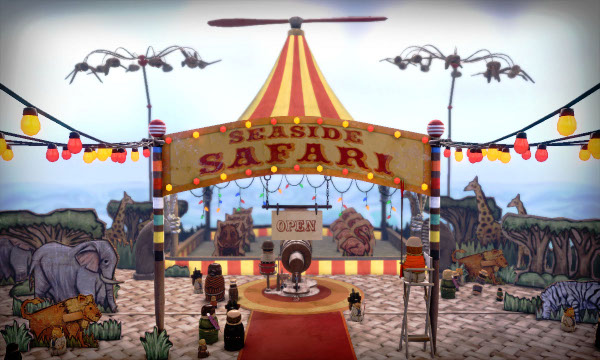
In case you missed the debut trailer for developer Double Fine's upcoming XBLA/PSN game, Stacking, here's the synopsis: It's about playing with dolls. Dolls that sip tea (naturally) or read the newspaper, dolls that peer through opera glasses to reveal secrets, dolls that white-glove slap.
They're Russian Nesting Dolls, specifically, and you control Charlie Blackmore, the littlest doll in a world of dolls. Which is actually a big advantage, because as a smaller doll you can “stack” into larger ones, assuming their forms and using their special abilities.
Like the gift of flatulence, for example. Tim Schafer and Project Lead Lee Petty are demoing the game for me, and Schafer's driving — he's stacked into a large, unkempt man of a doll and unleashes a foul wind near an air vent, which then clears out the exclusive party in the adjacent ballroom, completing one of the game's many Challenges. Petty describes them as like old-school adventure game puzzles, but dolls are the puzzle pieces, and each (replayable) Challenge has three or more solutions.
As Schafer doll-hops and Petty narrates, I lob a few questions.
Bitmob: What kind of difficulties did you encounter in trying to make a narrative-based game without combat in it?
Lee Petty: Do narrative games always have combat?
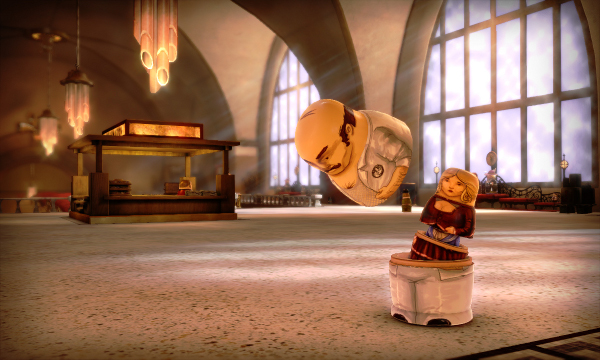
Bitmob: Well, aside from some point-and-click adventures and a few rare exceptions…yeah.
LP: Well, most games always have combat…I see what you mean, that's true.
Tim Schafer: What is combat for in a narrative game? In some ways it's to provide second-to-second gameplay. Because adventure games always had minute-to-minute or hour-to-hour gameplay, like trying to solve a puzzle, but the actual walking around wasn't really what you'd call gameplay — it was more just exploration.
What Lee's added with the HUD elements and the systematic approach to things, so that dolls react to each other based on class, size, and gender instead of a lot of specially programmed one-off behaviors, there's a lot more second-to-second gameplay in just exploring the dolls and testing them out.
LP: Things like the Hijinks system [editor's note: Hijinks are like achievements — specific tasks you complete], they've been really popular in our play tests, and I think those are a little bit of a feedback loop to encourage the player to stack in as many dolls as they can and test out the abilities.
It's funny, even before we had the Hijinks system some people really would love to grab one of those slapping dudes and just slap everyone they could and watch the reactions. They're all different — some of them [the slap] won't really work on and they'll chatter something…try to slap kids and they'll all duck it and call you "old man" and things like that. There's just a lot of moment-to-moment richness in that.
TS: You can get that guy with the gun, eventually. He has a cork gun, and you can walk up to guys and pop 'em with the cork gun, and they split in half for a second. And then they reform.
LP: I guess it's not combat.
TS: It's pretty intense combat.
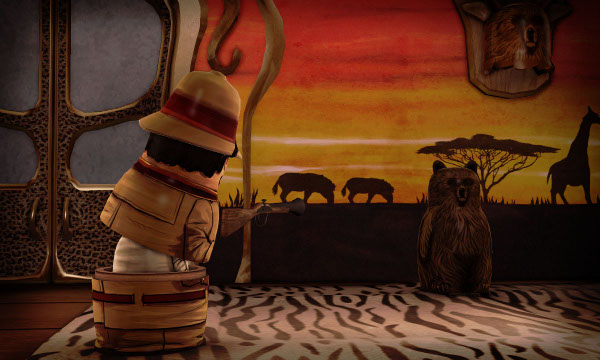
LP: It's aggression. We have some aggression. I always say, I really like the fact that we have Chopin in the game [as background music], but it's only really the combination of Chopin and farting that makes it magical.
TS: Chopin was a famous farter. Not a lot of people are really going to get that joke, but the ones that do, they'll laugh in here. <Points to his heart.> Quietly.
We talked about, in the early days…when you [think about] a Russian stacking doll — could be a platformer, could be a combat-centered game. But it seemed cooler without combat. It seemed like that would take over what you're doing most of the time, and this lets you really think about the puzzles at your own pace, and you don't have to worry about getting killed all the time.
LP: There are challenges with space design. With combat, I think so many people are used to combat even in non-narratively focused games, where that's the primary mechanism for moving people through space. A guy spawns over here and shoots you, "Oh, I'll go towards that guy." You kind of get pulled through the space.
I think it was a little bit of a challenge for us to let the player choose the order of the Challenges they do while still having it make sense in some sort of narrative context. But it felt a lot better to me to do that than the very linear, classical approach [in] some of the adventure games. And I think it meshed more with the idea of multiple solutions, and exploring the dolls for the dolls' sake. I mean, you get rewards, but they don't directly have to be tied to a specific objective all the time.
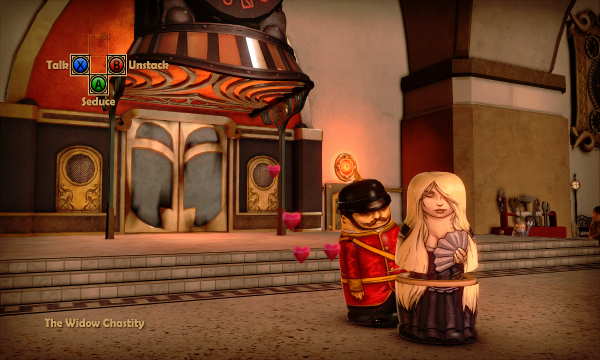
Bitmob: So did the whole idea for the project literally start with you looking at a Russian Nesting Doll and drifting off into a beautiful reverie of eurekas and body snatching?
LP: It kind of started with this idea, I was thinking, what type of game would be great to make at Double Fine, you know? I really loved adventure games growing up; I really loved that you could play them at your own pace. They weren't just about combat or aggression — there weren't really, generally speaking, a lot of death and fail conditions. But they still were interesting and really challenging.
I wanted to find a way to kind of capture that, and maybe avoid some of the stuff that I think a lot of people get held up on…[that] there's only one way to do things. It's really hard for everyone to get a logic puzzle even if it's well hinted at. It can involve a lot of searching for something, and it's not necessarily a consistent visual language because that's part of the challenge.
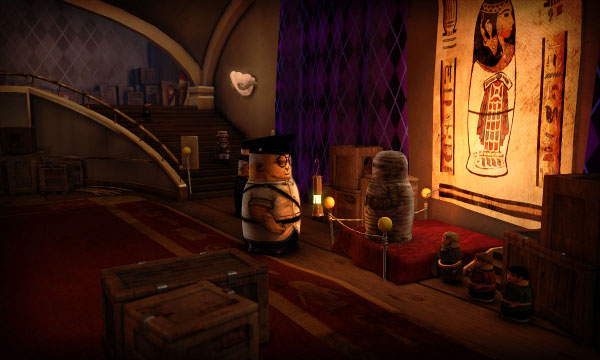 I thought if there was a way to sort of condense that, if the verbs and the objects and what you were doing was a little more immediate…. And I actually saw my daughter, when I was thinking about this, playing with a stack of Russian dolls. I thought, that's perfect! It offered this idea — you can change characters, you can change abilities. You don't need objects, because they are the objects. They're the things moving around. You can talk to them, you can get hints from them, then turn around and stack them and use them as part of the solution.
I thought if there was a way to sort of condense that, if the verbs and the objects and what you were doing was a little more immediate…. And I actually saw my daughter, when I was thinking about this, playing with a stack of Russian dolls. I thought, that's perfect! It offered this idea — you can change characters, you can change abilities. You don't need objects, because they are the objects. They're the things moving around. You can talk to them, you can get hints from them, then turn around and stack them and use them as part of the solution.
That just sort of launched all these other ideas…well, what sort of world would these live in? We wanted to avoid the idea that they were like toys on a peddler's shelf that came awake at night, like Toy Story. Rather, that they just exist in their own sort of like diorama, silent-film-influenced world.
The sizes of the dolls then lead you to start thinking about this idea of a pecking order or social class, or more meaning when they're put together in matched stacking sets, and the pieces of the story. There was just a lot of richness to explore there, and it was a challenge and a goal to always try and limit ourselves to not put arbitrary collectibles in the game; let's make them the tools, let's make them the dolls.
When we want to move the narrative forward, it's tied in to combining the dolls, and they're sort of stacked together almost like you're combining bits of information together to create something. It wound up being kind of a versatile idea that you could really take in different directions.
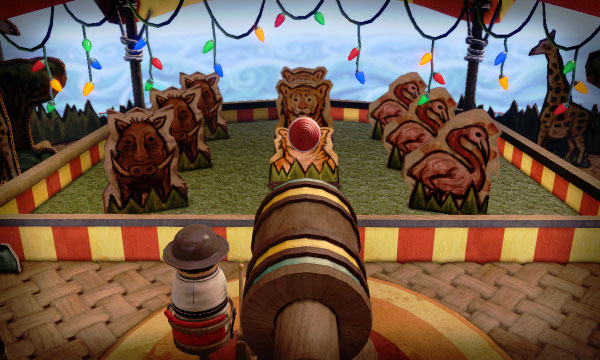
TS: Wait, who…who slaps the — oh, someone can slap a hat on someone. <Schafer's playing through a level that takes place on a cruise ship.> Or is that only the Haberdasher?
LP: The Artist. Well, in this level. There's a couple different variations.
Bitmob: So how'd you create all these dolls?
LP: We have well over 100 unique dolls, and they're all drawn by hand; we don't use any photo sourcing for any of the dolls. It's kind of our own style…kind of a simplification and exaggeration of some of the techniques they might use to paint Russian dolls. One of the big differences is that we found that adding little accessories like hats and violins — from a gameplay standpoint it's easier to figure out what they might do, but it also just gives them a little more charm.
<Shafer stacks into a dog doll as he plays.>
This is funny, we put a dog in there just to see if we could make a dog, so we put these little ear accessories on him. He's got dog vision, too. He occasionally drags his bottom on the ground when he does a trick.
<The surrounding dolls seem quite disturbed as Shafer's dog slides its ass on the ground.>
TS: Notice that it grosses everybody out?
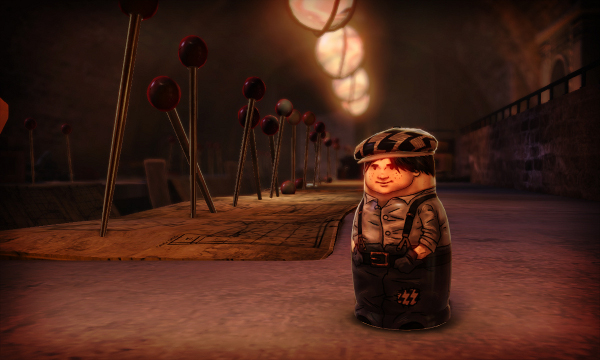 LP: They usually cheer when he does a trick, but once in a while they get a little upset if he drags himself. He's actually used as part of a matched stacking set, but he's also kind of fun to go around [in] — he walks on his back legs, does the drag, yeah, I don't like that.
LP: They usually cheer when he does a trick, but once in a while they get a little upset if he drags himself. He's actually used as part of a matched stacking set, but he's also kind of fun to go around [in] — he walks on his back legs, does the drag, yeah, I don't like that.
<Shafer's dog starts chatting with a rat doll.>
Here's an example, if you talk to a rat as a dog, they'll talk to each other, because they're speaking animal. But if you unstack out of this dog and talk to him as Charlie or any other character, they just make animal sounds. There's actually a ton of dialogue in the game, and the casual player may not find all of it, but there're a lot of jokes, and depth, and hints, all kind of tied into the player exploring.
TS: You can never stack the rats, can you?
LP: You can do something to the rats.
TS: I know, but you can't stack them. <Schafer tries to move behind the rat, but it turns toward him.>
LP: Can't get into the rats. They're too quick for you.
I was telling an animator, “I want you to make a dog walk on its hind legs.” And they were like, how am I going to do that with two shells? But it actually works out — you can kind of read what they're doing.
<Schafer, still in dog form, enters a large dining room.>
You've wandered into another Challenge area here, involving caviar. At the scale these dolls are the caviar's like these giant, unsightly, big black balls of goo, served sushi-boat style.
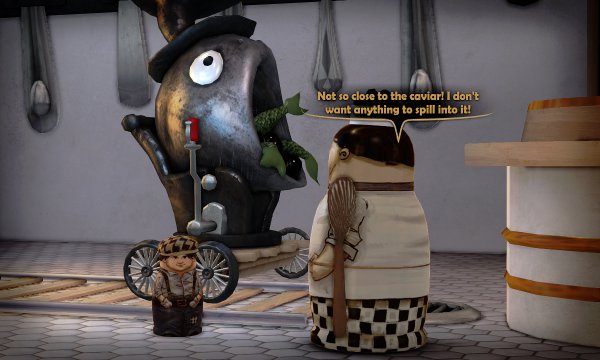
TS: Why's it caviar and gruel?
LP: It's the gruel buffet and the caviar bar. What else would it be, of course? It's Victorian era, everyone likes gruel.
TS: I like how shiny the gruel is.
